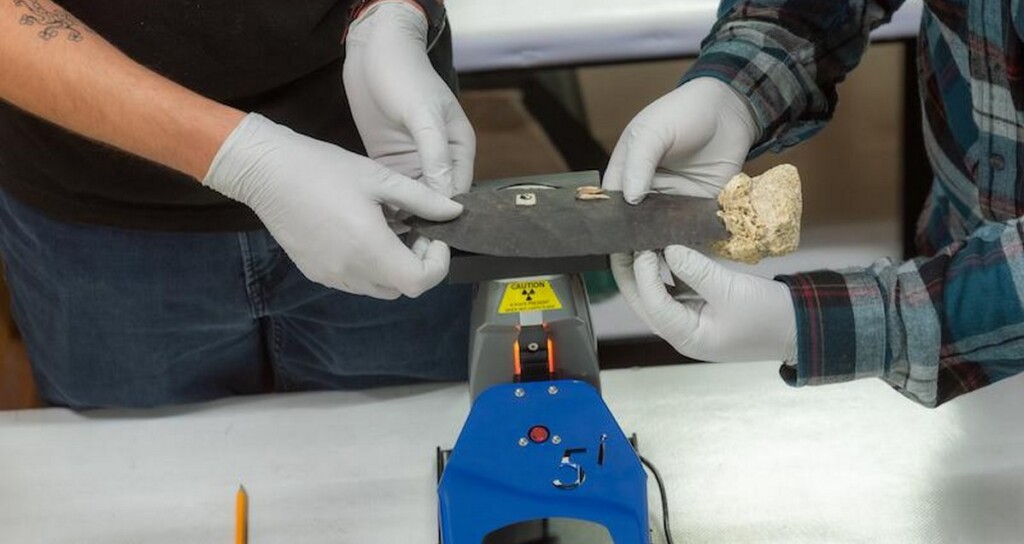 Analyzing one of the green obsidian objects found at Templo Mayor – credit Leonardo López Luján, via Tulane University
Analyzing one of the green obsidian objects found at Templo Mayor – credit Leonardo López Luján, via Tulane UniversityThere’s an old saying that if goods are crossing borders, generally soldiers don’t, a saying that new research has shown to be true even in the case of the warlike Aztecs in central Mexico.
A new study sheds light on the economic networks, rituals and political influence the Mexica Empire (the word the Aztecs used for themselves) relied on to maintain their economy and grip on power.
The research, conducted by Tulane University and the Proyecto Templo Mayor in Mexico, reveals how obsidian—a volcanic glass used for tools and ceremonial objects and one of the most important raw materials in pre-Columbian times—moved across ancient Mesoamerica and shaped life in its capital, Tenochtitlan.
Published this week in Proceedings of the National Academy of Sciences, the study analyzed 788 obsidian artifacts excavated from the Templo Mayor of Tenochtitlan, the main temple and core of the Mexica Empire located in what is now Mexico City.
Archaeologists found that while the Mexica primarily used green obsidian from the Sierra de Pachuca source, they also acquired obsidian from at least seven other locations, including regions beyond their political borders, such as Ucareo, in the Purépecha territory in West Mexico. The findings suggest a sophisticated economy that relied not only on conquest but on active long-distance trade, even with rival polities.
“Although the Mexicas preferred green obsidian, the high diversity of obsidian types, mainly in the form of non-ritual artifacts, suggests that obsidian tools from multiple sources reached the capital of the Empire through market instead of direct acquisition in the outcrop,” said lead author Diego Matadamas-Gomora, a PhD candidate in Tulane’s Department of Anthropology.
“By studying where this material came from, we can explore the movement of goods across Mesoamerica.”
The analysis showed that nearly 90% of the obsidian artifacts in the sample were made with Sierra de Pachuca obsidian—prized for its green hue and symbolic connection to the mythical city of Tollan. Almost all the ceremonial artifacts found inside buried offerings at the Templo Mayor were made with this type of obsidian, including miniature weapons, jewelry and inlays for sculptures.
A smaller but significant portion of the obsidian came from places like Otumba, Tulancingo, Ucareo and El Paraíso, some of which lay outside the control of the Mexica Empire. These materials were more commonly used for tool production and found in the construction waste piles, indicating that these obsidian types were available to the general population through local markets at low prices rather than being tightly controlled by the state.
The study also tracked how obsidian use shifted over time, from the city’s earliest phases around 1375 CE through its fall in 1520 CE.
ANTIQUE MEXICO: LiDAR Reveals Abandoned Fort Was Actually a Lost Zapotec City with Temples and Ball Courts
During the empire’s early phases, more variety in obsidian sources appeared in both ritual and everyday objects. After the Mexica consolidated power around 1430 CE, obsidian for ritual purposes became almost exclusively sourced from Sierra de Pachuca, suggesting growing religious standardization and centralized control.
“This kind of compositional analysis allows us to trace how imperial expansion, political alliances and trade networks evolved over time,” Matadamas-Gomora said.
MORE MESOAMERICAN HISTORY: Mythical City of Underground Labyrinths Found Beneath Altar of 15th Century Church in Mexico
The research was made possible through a partnership between Tulane and Mexico’s Proyecto Templo Mayor of the National Institute of Anthropology and History (INAH), with artifacts analyzed using portable X-ray fluorescence (pXRF), a non-destructive method that identifies the geochemical fingerprint of each artifact.
“This work not only highlights the Mexica Empire’s reach and complexity but also demonstrates how the archaeological sciences can be leveraged to study ancient objects and what they can tell us about past cultural practices,” said study co-author Jason Nesbitt, an associate professor in Tulane’s Anthropology Department.
YOUR FRIENDS Who Are Fascinated By The Aztecs Will Want To Read This…
Source link

